Bronckhorst [or Bronkhorst] (Netherlands) Special V-16
7-passenger ¼-window brougham with canework on lower rear quarters [like Fleetwood style
#4264-B but a longer body, with quarter windows added, full-sized jump seats folding into
partition] (¾ front, RH view and interior layout in Auto-Carrosserie No. 92, Figs. 16-18
[mentioned in earlier salon report in same magazine - maybe No. 91]). Images below
are from photocopies, so relatively poor quality..
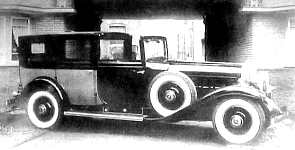
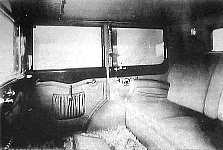
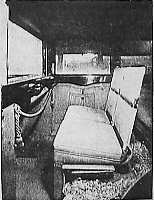
This could be the European tour car style 4264B
with a modified
rear body (addition of quarter windows and full width jump seats)
Eureka (USA), custom funeral coach on V16 chassis, McC
p.152
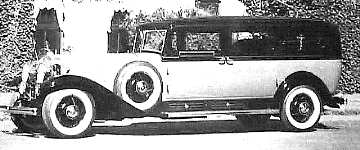
It is not known whether this body was built from
scratch or
whether it was a conversion on a regular V16 sedan body
(I would opt for the latter solution)
Farina (Italy) Special "Tiger Hunt" roadster. The text
in italics, below, is from a book on the Behring automobile collection by Rob Haeseler,
1988, published by the Behring Educational Institute, Inc. (ISBN 0-9617992-0-X), which I
saw in the Dick Sunderland collection 9/94:
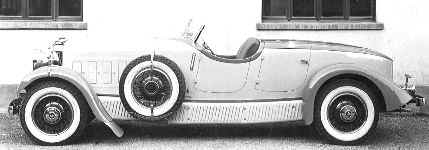
This photo was graciously provided by Mr. Fredy
Valentini
of Pinin Farina's PR, Turin, Italy, in the
seventies
"One of the finest achievements of automotive coachwork spanned
three continents and remained virtually unknown in the western world for half a century;
it was a 1930 V16 Cadillac [boat-tailed] speedster [car No. 266 - was this
chassis No. 7000266? - find out from Cadillac Historical Services] that had a stylish
Italian body and was designed for tiger hunting.
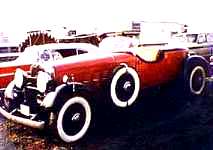
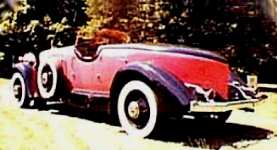
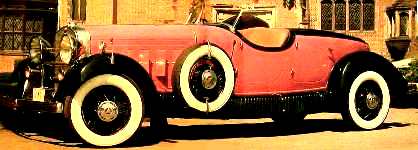
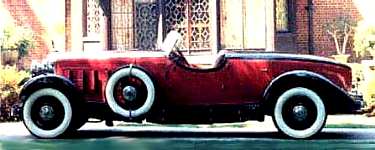
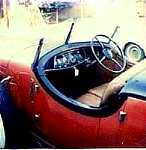
The PF boat-tail roadster looked like this when it came to the USA in the sixties.
It was owned for many years by Dave Towell, a Cadillac dealer from Akron, OH.
Dave it was who graciously supplied the above photos. Note that the car is RH drive;
only a handful of sixteens were built with this configuration
It's [sic] strange odyssey began on March 3, 1930 when an
event with far reaching consequences occurred in the ancient fortress city of Orccha in
central India1. On that day Maharajah Vir Singh claimed his ancestral throne. The succession
of the 29 year-old monarch was attended by the heads of the neighboring princely states
and by many of his 300,000 subjects, as well as by his 300-man army, and 600-member police
force. A 15-gun salute echoed through the 15th century temples that rose in steps from the
banks of the Betwo river. The boundaries of Orccha encompassed an area almost twice the
size of Rhode Island. Vir Singh's ascendancy placed at his disposal annual tax revenues of
31 million rupees or 4 million dollars. The new ruler celebrated by commissioning a noble
automobile.
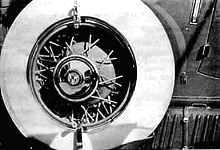
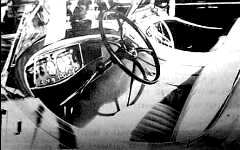
In the close-up, left, you can just make out the
"F" of the Pinin Farina logo, to the right
of the fender spare; the instrument board, right, is the standard Fleetwood model
for Detroit-built sixteens; notice, however, that the steering wheel is on the right
Only months before, the Cadillac Motor Car Company had unveiled its
new V16 engine, a silent-running powerhouse designed in secrecy to gain a competitive edge
over its rivals in the luxury field (i.e. Packard, Pierce-Arrow and Marmon). In its
enthusiasm to market the world's first production model V16, Cadillac shipped [32 of]
its bare chassis overseas. Whether one of them reached the General Motors distributor in
Bombay has not been recorded [three V16s were sent to Bombay - these may have been
complete cars] but the Maharajah's order to Detroit miraculously survived. At a cost
approaching 7500 dollars plus a 30% import duty the Maharajah of Orccha chose a V16
chassis with a phaeton hood, reinforced front springs, high speed rear end and high
compression cylinder heads. None of these features was particularly unusual for an export
vehicle, rather it was his request for right-hand drive and a steering column tilted at a
low angle that should have made Cadillac aware that the car would receive radical design
treatment. Factory records reveal that the chassis left Detroit on July 17, 1931 destined
for Turin, Italy. It might just as well have been lost at sea because for several decades
Cadillac cognoscenti were unaware of its existence.
At the time of the Maharajah's ascension the man who would later
become Italy's most renowned automotive designer was just setting out on his own. The 35
year old coach builder had left his brother's firm Stabilimenti Farina, to open a shop
under his own name: Carrozzeria Pinin [Gianbattista] Farina. The Maharajah's
tiger-hunting car was one of his first masterpieces. It has been acclaimed as more
graceful and more durable than any other car of its kind - a functional work of art. Pinin
Farina lowered the cowl and hood and joined them to a fashionable boat-tailed body [the
photo immediately below is of an earlier car - a 1928 Hispano Suiza - with an almost
identical body by French coach builder Gallé; this car may well have inspired Pinin
Farina or it may have been seen by the Maharajah and commissioned from Farina 2-3 years
later].
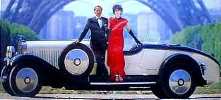
This boat-tail speedster by Paris' coach builder,
Gallé,
on the 1928 Hispano-Suiza chassis, probably inspired
Farina's subsequent "tiger hunt" car for the Maharajah
Forsaking traditional fenders and running boards he achieved a
sportier look by adding cycle fenders and applying louvered dust shields over the frame.
In the boat-tailed deck he installed small doors which opened onto a throne compartment
raised 12 inches above the front seat where the driver and footman sat. This innovation
not only enabled the Maharajah to be conveyed around Orccha at an elevation befitting his
rank, it also gave him a free field of fire when his beaters drove a beast from the bush.
The finished speedster that Pinin Farina shipped to Orccha by way of Bombay could achieve
speeds of up to 100 miles per hour, assuming superior roads for which the sub-continent
was not noted.
Over the decades the odometer slowly advanced averaging barely 135
miles per year. Time had been merciful but the machine had fallen into disuse and might
have been sold for scrap had it not been discovered and saved by an Indian classic car
enthusiast. [the article includes a photo of H.H. the Maharajah of Orccha]
According to my own sources, this car was purchased from the Maharajah's
family in the Sixties by Pakistani film star/director, Sheikh Mukhtar (deceased); it could
have been in the USA already in the late 60's - photos of the car taken at an U.S. auction
sale are featured in an old issue of the "Self Starter", journal of the
Cadillac-LaSalle Club]. The photo I got from Pininfarina archives in the seventies
is the same one in Dave Holls' personal photo archives; the latter was published in the
June '65 Self-Starter; the caption said the actual car had been shown in Motor Trend (I
guess around the same time - i.e. 2nd quarter 1965). Dave Towell, the Cadillac
dealer in Akron, OH, acquired this car a few years later; it is believed he was able to
have it shipped out of India or Pakistan under the guise of "farm machinery".
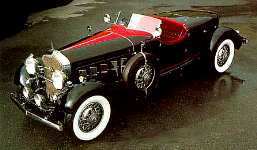
The PF "Tiger Hunt" roadster today;
just slightly "over-restored" in my opinion
Orccha was one of the Indian "salute"
states, during the British rule and before India became independent in August, 1947.
It ranked fourth in precedence of the Central India Agency states and measured 2079
square miles. Its ruler, Vir Singh ["singh" means "lion"] was a
Bundela Rajput [that is the son of a King], a Hindu of the Kshatriya [warrior] caste in
Central and western India. He was entitled to a 15-gun salute (the maximum was 21); only
five states ranked that high in 1931: they were (a) Hyderabad, (b) Mysore, (c) Baroda, (d)
Jammu and Kashmir, and (e) Gwalior.
Fleetwood (USA) V16, job #2950X, special 7-passenger Sedan [1
only]
Fleetwood (USA) V16 style 3289-B, special 7-passenger Town car [1
only]
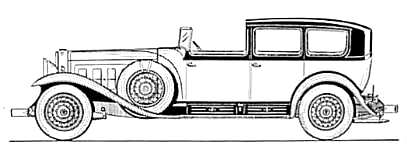
In the absence of factory photos or drawings
of this unique Fleetwood style
I am guessing it was one of the few Series 452A jobs bodied in early 1932
(hence initial digits "32"); the proximity of final digits "89B" to
"91"
suggests to me that it may have been a modified town brougham, style 4391,
with blanked out quarter windows and an all metal roof
Fleetwood (USA) style 3981 was described as a stationary
cabriolet (known also as a 4-passenger "Sedanette Cabriolet") that
is a sedan with fabric-grained roof covering imitating Burbank cloth; it had removable
center window posts [see drawing below], a wide upper belt molding that dipped at the rear
to simulate a convertible sedan style, and a small roof ventilator. Usually found on the
V8 chassis, a single one of these stylish hardtop sedan bodies was mounted on the Series
452/452A vee-sixteen chassis.
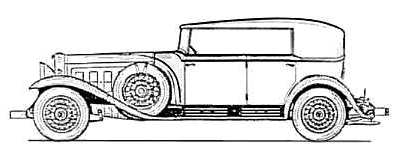
The drawing, above, is my own impression of how
Fleetwood style 3981 might have looked on the V16 chassis
Fleetwood (USA) V16 style 3991, Special 7-passenger Town car
(assumed standard V8/V12 body modified to receive V16 engine) [1 only]
Fleetwood (USA) V16 style 4108C, early, Pennsylvania-built style
4155C 5-passenger Limousine landaulet with almost vertical, split "V" windshield
and light-colored cloth or leather roof covering. This was the first vee-sixteen model to
be ready for show, in New York, in January, 1930; at that time it did not have the light
roof covering [it is possible that these were added later, in California, by the Don Lee
custom body shop [4 units built (or thus converted), only 1 known survivor]
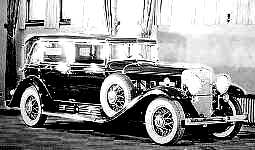
This factory photo probably was taken while the car
was
being readied for the New York Salon in January, 1930
Fleetwood (USA) V16 style 4130; two versions were built;
one with the almost vertical, split "V" windshield, built in Fleetwood,
PA, the other with an 18° flat, raked windshield, built in Detroit, MI. Seventeen units
in all were built; there may have been more than ten units with the flat windshield but
not many more than that. These cars are true "Madame X" models. There are at
least two known survivors with the flat windshield and possibly one more with the vertical
windshield.
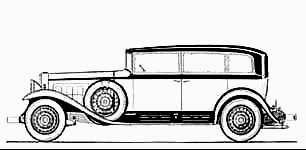
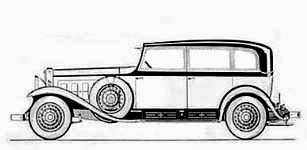
Left: the earlier version of Fleetwood style 4130,
with its almost vertical, split-"V" windshield.
Right (and below): the same car as built in Detroit and fitted with an 18º
slanting, flat windshield
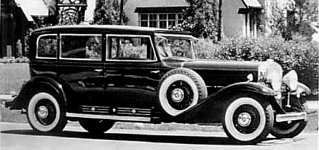
Fleetwood (USA) V16 style 4155, as above but with blanked out
rear quarters. Some were built in Fleetwood, PA, others in Detroit, MI. It is believed the
Pennsylvania-built cars numbered fewer than 10 units
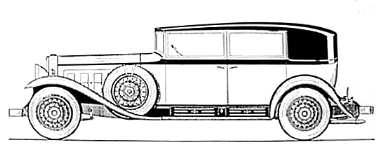
This early Fleetwood drawing shows Pennsylvania-built
style
4155; when outfitted with this light-colored top and collapsible
rear quarters, the style number changed to 4108C
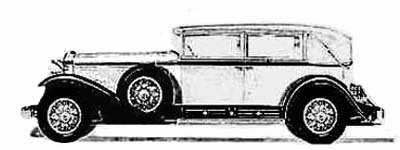

Fleetwood (USA) V16 style 4155C, as above but with 18° flat,
raked windshield, built in Detroit [5 units]; one
survivor in Switzerland (late eighties); at that time it was owned by Walter Grell of
Rheinfelden, near Zurich. The car had been used for many years as a fire-truck at
Illnau, in Switzerland. During restoration the former wind-up division glass was replaced
with a sliding type; the chauffeur interphone was missing as was also the silk umbrella
and holder. The tail lights were non-original.
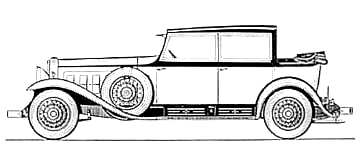
No drawing of this style was found in Fleetwood the
archives;
this one is by me; it is made up of parts of other drawings.
This is the style built at the old Fleetwood coach
works in PA
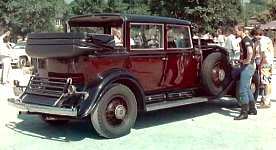
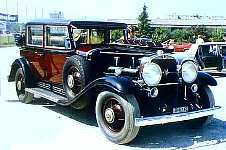
This unique survivor resides near Zurich,
Switzerland. It is job #18, indicating that the
series included also styles, 4155, 4155S, 4155SC and 4108C
Fleetwood (USA) V16 style 4155S, as 4155C but without division or
folding rear quarters [7 units]

No drawing of this style was found in Fleetwood
archives; this
one is by me; it is made up of parts of other Fleetwood drawings
This is the style built at the old Fleetwood
works in Fleetwood, PA
Fleetwood (USA) V16 style 4155SC, as 4155S but with folding rear
quarters [2 units]

A drawing of Detroit-built style 4155
was used to make up this landaulet version
Fleetwood (USA) style 4161 on series 452 V16 chassis, 148"
wheel base, described as a 5-passenger Imp. Club Sedan; this was one of the rare Madame X
styles owing to its flat, 18° slanting w/shield, slender "A" pillars and
light-colored or chrome-plated window frames [1 unit only]
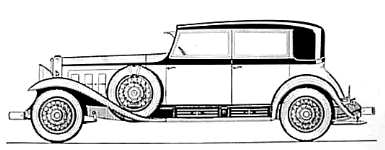

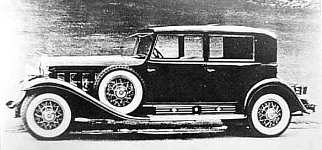
Fleetwood (USA) V16 style 4200, Special
7-passenger Sedan with light-colored leather roof covering [1 only]. This car was
completed in August 1930 for the Paris salon of October 1930; termed the "French
Brougham" it is described in detail on p. 94 of the GH book: "A
special 7-passenger "imperial cabriolet" (4-window berline) on the Cadillac V-16
chassis."
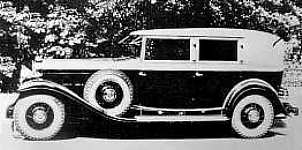
Fleetwood (USA) V16 style 4206, Special 2-passenger Coupe [1
only]

No drawing of this style was found in the Fleetwood
archives; this
one is by me; it is made up of parts of other Fleetwood drawings
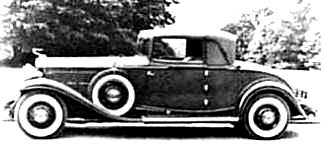
Fleetwood (USA) V16 style 4207, Special 2-passenger
Coupe [3 units]

No drawing of this style was found in the Fleetwood
archives; this
one is by me; it is made up of parts of other Fleetwood drawings.
Note the special belt molding on this particular car.
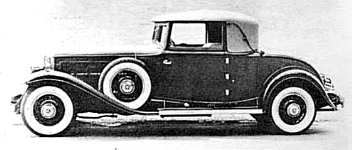
Fleetwood (USA) V16 style 4208, Special 5-passenger limousine
with light-colored leather roof covering similar to 4108C [7 units]

No drawing of this style was found in Fleetwood
archives; this
one is by me; it is made up of parts of other Fleetwood drawings
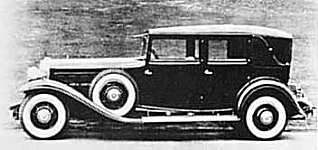
Fleetwood (USA) V16 style 4212, 5-passenger Town car [6 units]

Fleetwood (USA) V16 style 4212C, 5-passenger Town car with
folding rear quarters [1 only]
[drawing will be
made up]
Fleetwood (USA) V16 style 4220, 7-passenger Town car with quarter
windows [9 units]
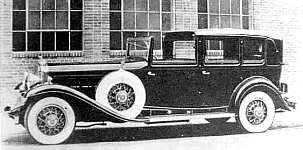
Fleetwood (USA) V16 style 4220B, as above but without standard
leather roof covering [1 only]
[drawing will be
made up]
Fleetwood (USA) V16 style 4225, 7-passenger Town car [6 units]
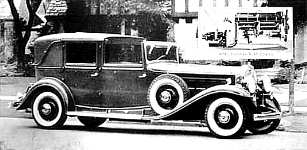
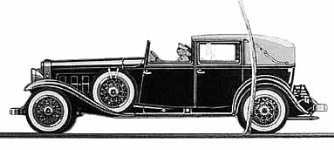
On the left is a factory photo of this Fleetwood
style.
Right is an artist's impression from a Dutch portfolio
of V16 styles in a private collection in Washington, DC
Fleetwood (USA) V16 style 4225C, 7-passenger Town car with
folding rear quarters [1 only]

Fleetwood (USA) V16 style 4257A, Special dual-cowl phaeton [1
only]

Unfortunately the size of these images and the low
resolution do not reveal the details
such as the special curved hood molding and the belt
line. This car is not known to have survived
Fleetwood (USA) V16 style 4257H, Special 7-passenger Touring car
with high top [1 only]


Fleetwood (USA) V16 style 4260, customized sport phaeton for the
movie "The Carpetbaggers", starring Alan Ladd.. It featured long-horns
atop the engine grille, leather door saddles, six-guns in lieu of door handles, a golden
horse and cowboy replacing the standard Cadillac hood ornament and a black and white
cowhide interior. This car was owned for many years by Richard Arlen [California license
tag #HNK283]. In the Eighties the car was restored to the original style 4260
configuration.
[Photo will follow]
Fleetwood (USA) V16 style 4260, special dual-cowl sport phaeton
[1 only ???]. Body #25, engine $702677; factory build sheet mentions Radel leather
upholstery, Burbank top, Driftwood Smoke body with Gold Bronze body stripe, 4.75-1 gear
ratio, 6 wire wheels, 7.00x19 whitewalls. This car was formerly owned by Ray and Dorothy
Radford of Portland Oregon; when Ray bought the car the secondary cowl had been dismantled
by its previous owner. It was later acquired by Bob Larivee and restored to 100-point
status. Article in TQ1-2/86, pp.4-9
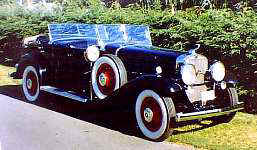
Fleetwood (USA) V16 style 4260, RHD [1 only ???], built for the
Maharajah of Tikari; current owner [late 1980s] Russ Head; C/C 9/83, pp.34-38.
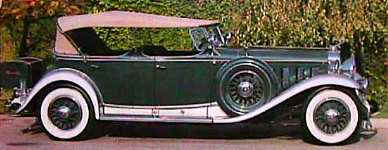
Fleetwood (USA) V16 style 4260A [1 only], Special dual-cowl
Phaeton with winding secondary windshield (official car - not pace car - at 1930
Indianapolis 500); tufted broadcloth upholstery [rare in an open car such as this],
chrome-plated hood vents, Fleetwood style "43" hood, special windshield, no belt
molding.
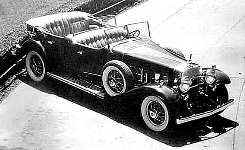
Fleetwood (USA) V16 style 4262, Special 7-passenger formal
limousine with leather roof covering and no quarter windows [1 only]
[drawing will be
made up]
Fleetwood (USA) V16 style 4264B [first type], Special town
brougham with "boot toe" sill (3 units built, no known survivors)
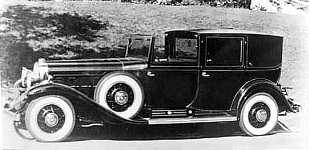
This is a "doctored" factory photo.
I simply took
the image, below, and blacked out the canework
Fleetwood (USA) V16 style 4264B m[second type], Special town
brougham, as above, but with canework meticulously applied by hand to the rear body below
the belt (3 units built, no authentic survivors, 1 re-body in Ohio).
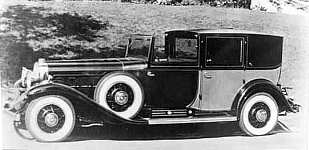
Fleetwood (USA) V16 style 4275, Special 7-passenger limousine
with curved coach sill [1 only]
[drawing will be
made up]
Fleetwood (USA) V16 style 4275C, as above but with folding rear
quarters [2 units]
[drawing will be
made up]
Fleetwood (USA) V16 style 4280, Special 4-passenger all-weather
phaeton with curved coach sill [3 units]
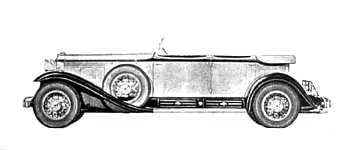
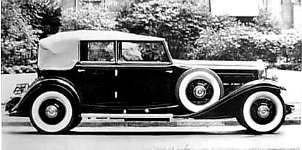
The actual car (right) is different from the
designer's drawing that
I found in an early Fleetwood album of styles available on the new V16 chassis;
the actual car has the curved, coach sill typical of styles with ID codes beginning
"42"
Fleetwood (USA) V16 style 4285 [2 units]
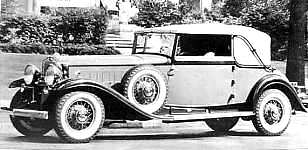

One of these very rare convertible convertible
"Victoria" styles was shipped to Europe (RH photo).
I wonder if it will ever reappear, after a long period of hibernation in some forgotten
hangar
Fleetwood (USA) V16 style 4325C [3 units, of which one went to
Germany - I have a rather poor photo of what appears be one of these three cars. It looks
like a large, 3-position V16 convertible sedan. It has the curved coach sill. The car
carries pre-WW2 German plates. On the other hand, it could be also a custom creation by a
German coach-builder. It has a Hibbard & Darrin look about it (light colored cloth or
leather top, closed rear but apparently fully folding).
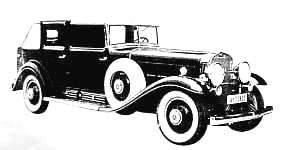
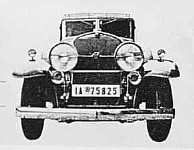
This retouched photo from the German magazine
"Motor" shows it with its original German
license tags
Fleetwood (USA) V16 style 4355C, Special 5-passenger limousine
with folding rear quarters [1 only]
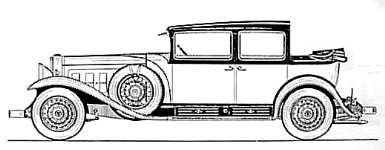
Fleetwood (USA) V16 style 4361, Special 5-passenger
club sedan fitted with division glass [2 units]
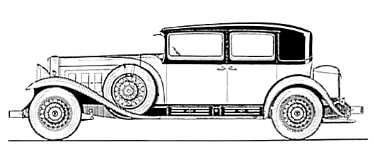
Fleetwood (USA) V16 style 4375 (?), at least one custom-built for
gangster Al Capone [details from flyer picked up at Imperial Palace collection, Las
Vegas]: top speed alleged to be 120 mph (questionable considering contemporary V16 road
tests), bullet-proof windshield and side glass, quarter-inch armor-plating lining driver's
compartment, three-inch portholes in side windows [one inch from bottom of glass] to allow
firing a submachine-gun without lowering the glass, tube through floor board for dropping
one-inch roofing nails in the path of any cars in pursuit, pressure can and tubing to
introduce oil into the exhaust system and thus create a smoke screen.
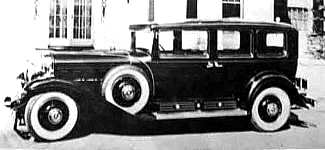
Fleetwood (USA) V16 style 4375C, Special 7-passenger limousine
with folding rear quarters [2 units]

Fleetwood (USA) V16 style 4412, Special 5-passenger Town car
presumably with full, horizontal belt molding and plain instead of scalloped hood. [1
only]
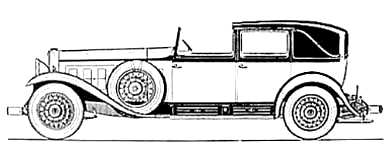
In the absence of a factory drawing or photo, this is
my
own impression of what Style 4412 may have looked like
Fleetwood (USA) V16 style 4476, Special 2-passenger stationary
coupe with rumble seat. Although 11 units were built, in my opinion it is scarce enough to
warrant a place in the Dream Cars section.
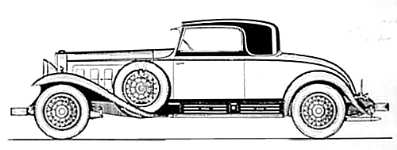
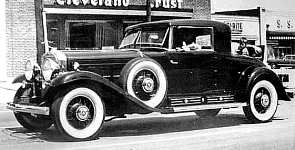
Fleetwood (USA) (?) Possibly a re-body since there
is no trace of this car in factory records for 1930-31. It is a 1930 V16 chassis
fitted (by Fleetwood?) with a 1929 sport phaeton body. It has a so-called "La
Baron" scalloped hood with a large circular molding extending into the front doors.
For many years the car was featured in the Obie Autorama collection on Long Island. I have
seen it for sale by auction a couple of times in the last ten years [1985-1995]
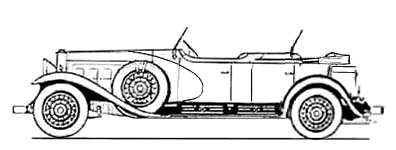
This drawing (top) was made up by me
from parts of other Fleetwood styling drawings.
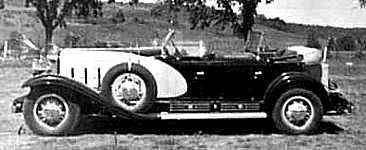
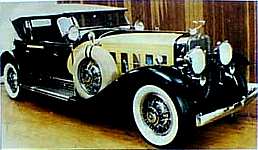
The photo above, left, was taken at the Obie "Autorama" on
Long Island.
The photo above (right) was taken at an auction sale in the late eighties
Kellner (France) on V16 chassis. No full view
available. Appears to be a three-position town car (sedan, town car or fully convertible
sedan - compare with photos of Kellner-bodied 1928 Hispano-Suiza on p.65 of Christie's
1980s Monaco auction catalog). Flat, rear sloping windshield (unpainted, maybe chrome or
nickel-plated), center-hinged [front "suicide"] doors like Fleetwood style 4380;
doors reach down and cover lower frame rails (like Van den Plas landaulet). Large landau
irons reaching well below belt line. Broad belt molding. Large grab-handle on
"C" pillar quarter panel in typical Kellner fashion. No spare tire cover [1
unit]
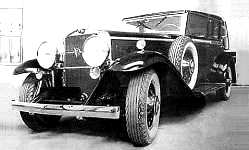
Murphy (USA) Special Cadillac V16 convertible Touring Car.

Nordberg (Sweden) Special Cadillac V16 Town car, SSA 1977,
p.16-19. This car is fitted with a sun visor, windshield pillar mounted turn-signal
indicators and a landaulet body; it has a swing-out windshield, a leather canopy over the
driver, a lacquered leather landaulet roof; the body is painted black and the passenger
compartment is upholstered in light brown (tan) cloth; black leather is used for the front
compartment; various woods are used for the interior moldings and the smoking and vanity
cases; two trays are stored in the capping below the division glass; it has opera seats
and blinds for all rear compartment windows, with silk pulls; there are rear quarter lamps
and assorted crystal vases. The car was delivered by Nordberg to the "Marble
Halls", the showrooms of Hans Osterman AB, the Swedish Cadillac distributor. It was
purchased right off the showroom floor by the publisher, Vetus Petersson.

Rollston (USA) Special V16 roadster.
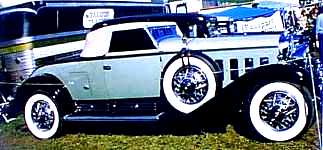
This is what the Rollston roadster looked like in the
late
seventies when it was owned by Peter Hinrichs
Saoutchik (France) Special Cadillac V16 5-passenger, 2-door
convertible Phaeton. Photo Sch16 p. 70
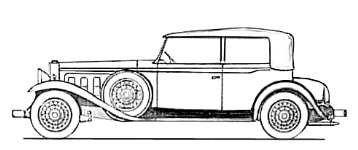
Drawing by Y. Saunders, 1988
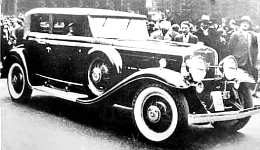
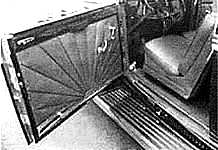
Photos: from pre-war French magazine;
note very French "sunburst" door panel design
Saoutchik (France) Special V16 with (part) convertible sedan
body. Entire top portion of roof slides rearward until sun-roof area lines up with
back-light. Car was re-discovered in a Paris garage, in 1964 where it had been seized for
non-payment of a repair bill. Later in the Johnny Thuysbaert collection, then Hubert Le
Gallais, this car returned to the USA in the 1980s (I guess) and was fully restored (owner
in 1993: Barnie Gliebermann). The original Marchal headlights have been removed and
replaced with Grebels (presumably to match the two accessory, running-board searchlights).
This car was built on the chassis of the European tour car, style 4260; the body
of the latter car was mounted on another V16 chassis. The Saoutchik car attended the
"Cadillac Experience" meet at the Gilmore Museum in June 1993; I have
photos provided by Katie Robbins, Michigan Region CCCA]
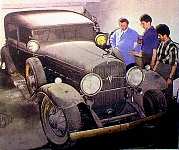

The photo at the left shows the Saoutchik
convertible sedan
when it was discovered in a Paris garage, in 1964; it was fully restored
and shown in various old car meets in the Paris area in the seventies (right)

And this is how the special sedan looks today, after
a full-scale
"over-restoration" in the USA; note how the original Marchal
headlights have been replaced with bulbous Grebels.
[Unknown, USA] Special Cadillac V16 roadster with a plethora of
dashboard and other instruments (photo, below, from Classic Car Club of America).
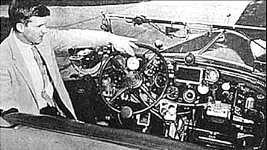
Van den Plas (Belgium), Special V16 Town car
Landaulet; VdP built a number of other bodies on RHD Cadillac chassis including a fully
collapsible, 3-position. Sedan in 1929 [McC, p. 133] two Town Landaulets (one on
1929 V8 chassis [McC, p.134] and this one on the 1930 V16 chassis with engine
[chassis?] #702297. The report published in The Motor (UK) on October 21, 1930
described the V16 landaulet as having extra-wide doors with private locks and center
armrests to the front and back seats. It said "The two comfortable occasional
seats face forward and are concealed in the partition when not in use. The partition has a
one-piece winding window. The landaulet has a fitted cabinet between the occasional seats,
the companions are incorporated in the inlaid garnish rails and the silk blinds are
concealed. The Colour scheme is light blue picked out black."
This car too is illustrated in a
beautiful advertising portfolio of which I received photos from the ZTV collection in
Washington. The descriptive text reads: "Saloon Landaulet de Luxe, Coachwork by
Carrosserie Van den Plas, Brussels, on V16 Cadillac chassis. The body is painted in a
charming shade of powder blue, wings, head leather and bonnet [in America: hood]
are black. Upholstery is a pale gray superfine box cloth. This elegant body has wide doors
and ample head room, despite its low slung appearance. The interior is fitted with two
armchair Pullman seats and two extremely roomy occasional seats which face forward and are
provided with side rests. Safety glass. As supplied to the honourable A.H. Guiness."
The interior woodwork is in dull
walnut. I believe this is the car advertised for sale in Motor (UK) on January 15,1935, on
p.75, by London's Cadillac dealers Alpe & Saunders (no relationship to me!), of
Providence Court, North Audley Street (opposite Selfridge's). It was described as a "Double-enclosed
1930 Vanden Plas, leather, forward occasionals, superlative condition throughout,
£2450" [cheap considering the advertised price of £1500 for a bare V16 chassis
alone]. We don't know much about the car's history other than it was later shipped back to
America at one time and was owned for a while by the late "Cadillac Jim" Pearson
of Kansas City. It may have been sold subsequently at auction [at the "Movieland
- Cars of the Stars" auction]; this could confirm my suspicion that the car may
have been owned, at one time, by Sir Alec Guiness, star of the British screen [the first
owner was a Hon. A.C. Guiness, in England].
Writing about this car in 1977, my
friend Roy Schneider, author of the magnificent book "Sixteen Cylinder Motor
Cars", said that the Can den Plas V16 landaulet that I had mentioned to him
indeed had showed up at a Movie-World auction a while earlier. "The car was in
deplorable, but restorable condition. It literally needed 'everything' including some
highly talented enthusiast with some heavy funding. It didn't sell, of course, and
apparently went back into storage somewhere."
It was subsequently acquired and
restored by J.C. Leake, the well-known automobile collector and dealer in Oklahoma City. I
have excellent period photos as well as many I took in Tulsa, Oklahoma, during the final
stages of its restoration in the early eighties. In 1977, Mr. Leake wrote that this car
has "the greatest amount of inlaid wood throughout the car that I have ever seen
and there is also much brass." He added, "The Vanden Plas is a
very low mileage car; it spent most of its life in damp storage I suppose, as it has quite
a lot of surface rust. When restored, however, it will be some car!"
The car was first offered at
auction, in Tulsa, in June 1977. Its present whereabouts are not known but it is
quite possible the car is still in Oklahoma.
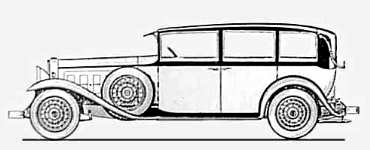
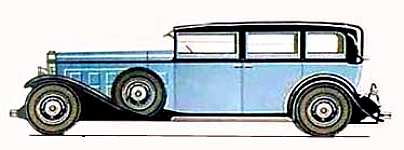
Drawing by Y. Saunders, 1988
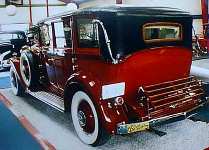
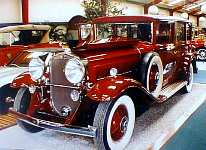
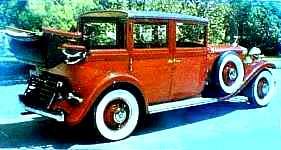
Above three photos: the restored car
Van den Plas (Belgium and UK): 5-passenger sports saloon, RHD,
special fenders, no running boards (step plates instead), sun roof, painted French gray.
This car was advertised for sale [new ???] for £2350, in the British The Motor for
March 24, 1931. It is believed this car was built with V16 engine #702873. It resembles
closely another British body reported as having been built on the V12 chassis [see "Dream Cars", 1925-34].
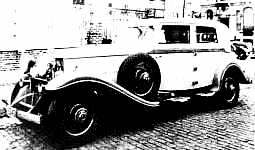
Voll & Ruhrbeck (Germany) Special V16 roadster. Poor photo in
book on German coachwork by Halwart & Schrader. This company also built a convertible
Victoria body on the 1932 V12 chassis.
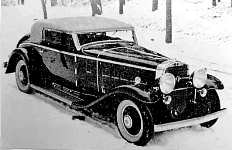
Waterhouse (USA) Special Cadillac V16 Town car Landaulet.
